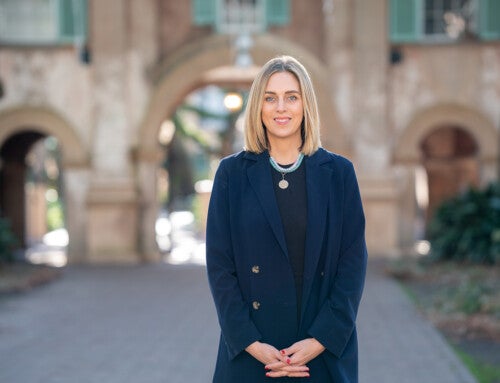Remember when solar energy seemed like some far-flung innovation of the future? Images of early solar cells from a few decades ago made solar technology seem like something from the sci-fi thriller 2001: A Space Odyssey.
Today, solar panels are a reality, rising in popularity as the next big thing in green energy. The sun-loving tech holds a lot of promise, not only as a clean, renewable energy source, but also as a way to alleviate power grid challenges for smaller countries with limited resources and land.
College of Charleston junior Skye Pelliccia has designed a new app aimed at helping property owners on the Caribbean island of St. Thomas understand the potential benefits of solar panels for their specific home or business with the simple click of a button.
“I wanted to raise awareness that you can save so much money and energy with solar panels,” says Pelliccia, a geology major.
There is growing interest in solar energy in the U.S. Virgin Islands, where the legislature voted in 2009 to require that 30 percent of its peak demand energy-generating capacity come from renewable resources by 2025. The small size of these islands, including St. Thomas, poses a particular challenge for renewable energy, says Pelliccia, noting that the limited amount of space makes geothermal and wind energy less practical.
“The only renewable energy they can fit there is solar because it’s so cramped,” she says. “In terms of renewable energy, it’s the most efficient.”
Pelliccia’s project was conducted through a partnership between the College and the University of the Virgin Islands. But what started out as an assignment to trace St. Thomas’ 16,000 rooftops for input into GIS sotware turned into something more when the enterprising Pelliccia decided to take the effort a step further. The resulting app offers specifications on the best location for solar panels on every rooftop on the island, the cost to install them, the potential for generated units of watt hours per square meter, the potential savings on a property owner’s power bill and possible savings through tax credits and rebates. Pelliccia’s research was funded through a $6,000 grant from the South Carolina Space Grant Consortium, a NASA affiliated program housed at the College of Charleston.
 But making the app wasn’t as simple as plugging in a few strings of code along with a rooftop graphic. The amount of information involved meant Pelliccia had to run multiple data tables, including Lidar data, GIS data and energy analysis. Then she had to manually create code scripts to condense the information down to something easily accessible and combine all the data into one layer.
But making the app wasn’t as simple as plugging in a few strings of code along with a rooftop graphic. The amount of information involved meant Pelliccia had to run multiple data tables, including Lidar data, GIS data and energy analysis. Then she had to manually create code scripts to condense the information down to something easily accessible and combine all the data into one layer.
To say it was an exercise of trial and error would be an understatement. “It failed more than it succeeded,” Pelliccia says with a laugh.
So when she finally clicked on a rooftop image of a St. Thomas home and a scroll of information on solar panels filled her screen, Pelliccia cried. “It was like the relief of the world was off my chest,” she recalls.
All her hard work was worth it: The Geological Society of America selected Pelliccia’s app for presentation at its annual conference in September 2016. And there’s interest in adapting the app to promote the solar potential of structures in other communities, including Charleston, S.C.
The experience, she says, taught her how to problem solve, troubleshoot and persevere, all while focusing on something she’s passionate about – the environment.
“I love science,” she says with a smile.





